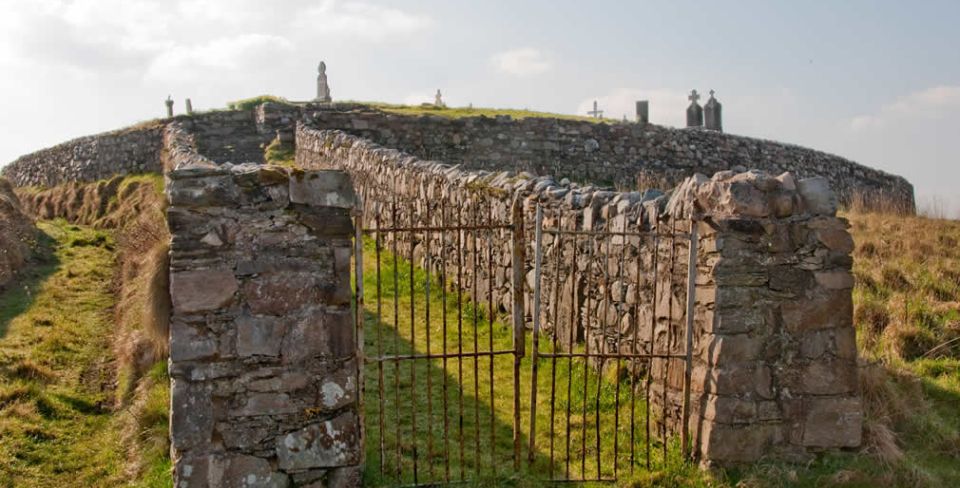2.10 Tullaghobegley
The ruins of the late medieval Tullaghobegley Church and graveyard lie on a small mound just to the south of Falcarragh. This tulach – or ‘low hill’ or ‘mound’ – was probably used for tribal inauguration ceremonies or other gatherings.
Remains of other ancient monuments can be found nearby including burial grounds, a holy well and the prehistoric Cloghacorr Court Tomb. This suggests that the area was a focus for rituals as far back as c.3000BC.
The parish of Tullaghabegley covers a large area of this northwest corner of Donegal. The area is named after and connected with a local saint – Bigill, Tulcha or Bigill of Tulach. It is possible that this saint and the practice of celebrating his feast day on 1 November, have their origins in pre-Christian pagan belief when the feast of Samain was celebrated on this same day.
The name of the mythical figure of Lug may offer another explanation for the origin of Tullaghobegley. An early name for this mound and its church was Talgalug in Latin or Tulach Logha in Irish which means the ‘mound or assembly place of Lug’.
Locally the saint is also known as Beigbhile or Beaglaoch and is claimed to have been a relative of Colmcille. Beaglaoch appears in the story of how Colmcille came to convert Tory Island by winning a staff-throwing contest – Begley’s staff only made it as far as Tullaghobegley which is why he built his church on this site.
Another story collected locally claims to explain why the church was here:-
Beaglaoch was traveling through the Muckish Gap, wandering ‘with no fixed destination … except that he knew that God was telling him to keep on going.’ He had no possessions, except for a donkey which he had found lost and wandering. The donkey was ‘unbiddable’. As evening came on, the saint sat down to rest, leaving the donkey to range free in the fresh grass. As he sat there, the saint had ‘some sort of vision’ and realized that he had reached his destination.
Wherever the donkey settled himself for the night was the site for the new foundation. So the saint tracked down the donkey, and found him easily enough, settled down for the night on a grassy mound – a place, as it happened, where the local pagans engaged in their heathen practices of celebration and commemoration of their gods. Beaglaoch [St Begley] took possession of the place. He blessed it in the name of the Lord. He expelled the superstitious heathens. And that is how God brought Beaglaoch to the tulach.
(quoted from: Tulach Beaglaoich inné agus inniu. Glór na nGael, An Fál Carrach, agus Cumann Staire is Seanchais Chloich Cheann Fhaola)
Cloughaneely and Tory Island
- 2.1 An Chros Tau
As you arrive in Tory the first site to greet you is the Tau Cross. Sitting high on a plinth, the T-shaped stone cross is a symbol of the island’s Christian heritage. The cross is thought to date from early medieval times and is carved from one piece of mica...
- 2.2 The Old Graveyard
The graveyard is believed to be on the site of an Teampull Buí which was the main church of a former monastery on Tory. An early Ordnance Survey map shows the remains of ‘St Columkille’s church’ in the southwest corner of the graveyard although no remains are visible today. There are many...
- 2.3 The Bell Tower
The Bell Tower is the only surviving round tower in Donegal. Although it's nearly 13 metres tall, it is among the smallest of these towers in Ireland. Its date is not known but could be as late as the 12th century. The granite stones used to make the tower would...
- 2.4 St John’s Altar
This altar dedicated to St John the Baptist is just beside the Bell Tower. There are a number of stones here - including a stone trough, decorated stones and slabs, a quern (millstone) and the remains of the base of a cross. It is said that the hollow stones were used...
- 2.5 St Brigid’s Oratory
The stone altar of St Brigid lies between the islanders’ houses. On top of the altar are three quern stones (used for grinding corn) and two granite slabs. As well as Ulaí Bhríde there are remains of two other small chapels - or oratories - on the island. At one...
- 2.6 Church of the Seven
These are the only chapel remains on Tory Island. In Irish this place is called Móirsheisear which translates as ‘big number six’ and which is an old Irish word for the number seven. Islanders tell the story that the site is the tomb of seven people who drowned when their boat was...
- 2.7 Rock of the Hound
© Alan Sproull Local tradition says that when Colmcille first arrived at Tory island he was met by the local king Oilill who refused to let him land. Colmcille asked if he could simply have a piece of land the same size as his cloak on which he could build...
- 2.8 Cnoc Na Naomh
Local legend says that Colmcille stood on this hill - Cnoc na Naomh - with his companions Saints Fionán, Dubthach and Begley. As they stood here above Magheraroarty, they discussed who would have the task of converting the Tory islanders to Christianity. They decided to answer the question by throwing...
- 2.9 Ray Church
Ray (pronounced ‘Rye’ in Irish, Ráith), is an ancient church site remarkable for its links with the abbey of Iona, and for its very tall high cross - 5.56m, one of the tallest if not the tallest in Ireland. The church stands on the east bank or the river Ray...
- 2.10 Tullaghobegley
The ruins of the late medieval Tullaghobegley Church and graveyard lie on a small mound just to the south of Falcarragh. This tulach - or ‘low hill’ or ‘mound’ - was probably used for tribal inauguration ceremonies or other gatherings. Remains of other ancient monuments can be found nearby including burial grounds,...










Bòrd na Gàidhlig
Great Glen House
Leachkin Road
Inverness
Scotland, IV3 8NW
(+44) 01463 225454
colmcille@gaidhlig.scot
Colmcille
Foras na Gaeilge, 2-6 Queen Street
Belfast
Northern Ireland
BT1 6ED
(+44) 028 9089 0970
colmcille@forasnagaeilge.ie
Colmcille
Foras na Gaeilge, An Chrannóg
Na Doirí Beaga
Gaoth Dobhair
Donegal, Ireland. F92 EYT3
(+353) 074 9560113
colmcille@forasnagaeilge.ie


